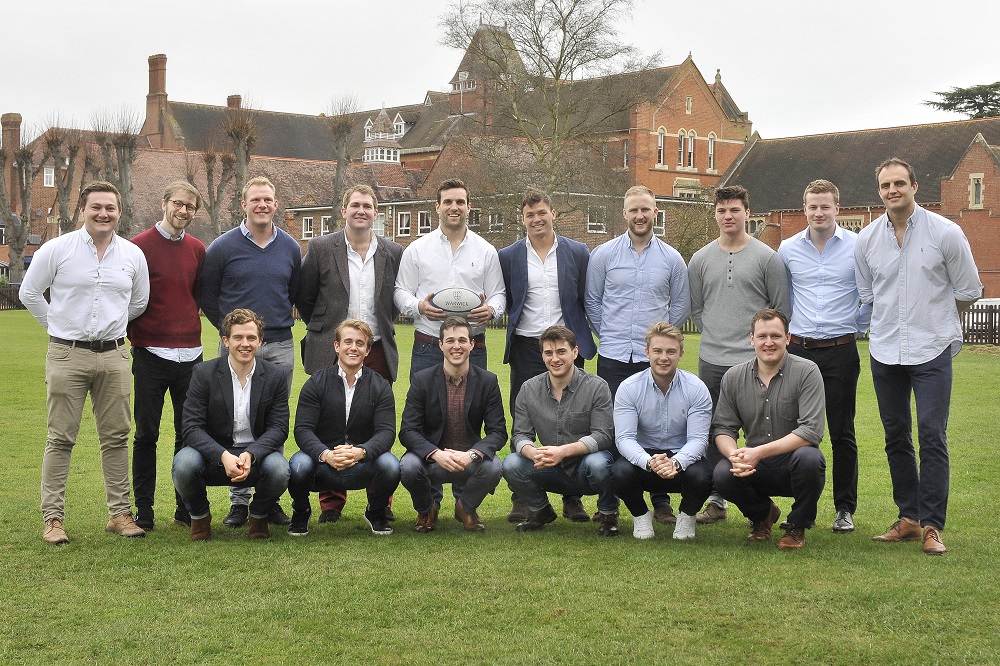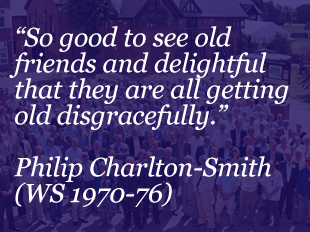Horace Seymour Pyne (1863-1950)
H. S. Pyne was born on 8th April 1863, in Worthing, Sussex, the son of William Washington Pyne (1835 – 1879) and Louisa Pyne, née Wright (1830 – 1920). He was the eldest of five sons of William and Louisa Pyne, his father being the headmaster of Lancing Grammar School from 1862 until his early death. Horace attended the same school from 1874 to 1881. This was a short-lived grammar school (c. 1820 to 1887) and is not to be confused with Lancing College. Immediately on leaving school he worked as a resident assistant teacher at Holt House, Cheshunt, Herts – a small school of 12 boys aged 9 to 16 - before moving to the Grocers’ Company School, London, from 1883 to 1885. This school has a very unfortunate 20th century history, from 1944 being called Hackney Downs School, and described in the 1990s as “the worst school in Britain”. It was therefore closed in 1995.
Horace moved to the Isle of Man in 1885 and was the science master at King William’s College, Castletown until 1899. At the start of his career there he was still without any sort of degree, and so he matriculated in London University (as an external student) in 1891. Just before moving to the Isle of Man, however, Horace had married London-born Hannah Huxley Sibley (1861 – 1955) in July 1885, in Hackney, and all of their five children were born in Castletown, IOM. Hannah was the daughter of John Francis Huxley Sibley (1831 – 76) and Hannah Wood Huxley Sibley, née Clarke (1834 – 1906).
Here we encounter a significant sadness for the Pyne family, for three of their five children died before either of their parents.
Horace Orry Pyne (1877 – 1927) attended the King’s Middle School, Warwick, from 1899 – 1905 and had a career as a marine engineer’s assistant. He never married, and died at the age of 40. It would seem that he never saw active service in the First World War, and was described by an OW as “poor Orry”. It may be that he had some sort of learning difficulty.
Mona Grace Pyne (1899 – 1901) died tragically young at the age of 12.
Ethel Huxley Pyne (1891 – 1985) married Capt. Cecil L. W. Bagshawe, later a member of the London Stock Exchange, in 1918 in St Nicholas Church, Warwick. It is not thought that they had any children.
Arthur Huxley Pyne (1892 – 1969) attended the King’s Middle School, Warwick from 1901 to 1906, and Warwick School from 1906 to 1912. He completed only the first year of an engineering course at Birmingham University from 1913 to 1914, at which point his father employed him at Warwick School as a “drawing and woodwork master, with practical engineering”, from 1914 to 1915. He then joined the 14th Batt, Worcestershire Regt. In Portcullis magazine of April 1917 he is reported to have fought with the Salonika force, and was in hospital, “his condition being reported as serious”. In 1922 he married Eva Kate Scarr (1889 – 1958), the daughter of Mrs Hainworth, and the step-daughter, therefore, of the head of the Junior House, A. D. Hainworth (WS staff 1907 – 38). It is reported that this marriage was over by 1926, and they did not have any children. Eva Pyne became a great friend of the Ridings (G. A. Riding was headmaster after H. S. Pyne) and Riding even employed her at the school for “raffia work and piano teaching” between 1929 and 1931.
Eric Wilfred Pyne (1897 – 1917) attended Warwick School from 1906 to 1916, and was an outstanding sportsman as well as being “Captain of School” from 1915 to 1916 (ie head boy). By the time he left he had accumulated 23 cups for excellence in sports. In 1916 he joined the Army Service Corps Motor Transport company, but was unfortunately aboard the Motor Transport “Transylvania”, carrying over 2,000 troops, when it was torpedoed off the coast of Italy on 4th May 1917, with the loss of 412 lives. His father commissioned Warwick School chapel gallery and west window in his memory.
Horace’s first degree was an external BA from the Royal University of Ireland in Belfast, formerly known as the Catholic University of Ireland, in 1896. This was a short-lived institution – it only lasted from 1879 to 1909. This BA was followed by a BSc the following year. After a gap of 18 years he collected two more external degrees (by thesis) from Trinity College, Dublin – BA in 1915 and MA in 1918. In the 1915 thesis he laments that he was not able to complete the work at Birmingham, on the grounds that the young university had been turned into a military hospital. He completed the work in the laboratory at school, and, indeed, a physics laboratory in what is now the music block was named the Pyne Room until 1957. Apart from the war-time period, he had access to the laboratories of the newly-chartered University of Birmingham in the summer holidays, and developed a warm friendship with its Principal, Sir Oliver Lodge (1851 – 1940). The then Dr Lodge had blotted his copy-book with regard to Warwick School (in the opinion of the then headmaster, Rev Robert Percival Brown) in 1901, in a speech at the King’s Middle School, where, of course, H. S. Pyne had been headmaster since 1899, in declaring that grammar schools (like Warwick School) had “had their day, and the way forward was science”.
At Easter 1899 the Pyne family moved to Warwick, where Horace had secured the post of headmaster of the King’s Middle School in The Butts. In a foretaste of things to come, he relieved all the existing teaching staff there of their posts, and started his reign there with his own selection of teachers. Very soon the Middle School became a Centre of Scientific Excellence, which was not its original purpose when it was set up in 1875, which was to educate local boys for commerce, and only up to the age of 16. By 1905 Pyne had changed the name of the school to the King’s County School, and an official complaint was made by the Board of Education not only about this, but also that Pyne was taking in boys of sixth-form age. Moreover, he had also been taking in boarders in his own home since 1900. “There is evidence”, said the Board, “of a deliberate intention on the part of the authorities of the Middle School unduly to compete with the Grammar School.” It would also seem that his colleague, M. M. Clark, also housed boarders for decades, especially in his house on Emscote Road.
For the whole of his seven years at the Middle School, Pyne kept meticulously-compiled scrap books containing cuttings of every local newspaper article about his school and the Grammar School over the water. These scrap books are almost the only Pyne archives which have survived. His school prospered, and the Grammar School floundered during this time, and it has to be remembered that the two schools were in the same Foundation, and were intended to serve different types (ie social classes) of pupils. The Earl of Warwick, chair of governors of both schools, could hardly have been more partisan, and for the first six years of the 20th century the King’s Grammar School shed pupils and staff, and went badly into debt. It had two headmasters during this time, the severe Rev Robert Percival Brown, who was sacked in 1902, and the weak Rev William Keeling, who jumped ship at Easter 1906. Pyne simply waited in the wings.
The extraordinary summer of 1906 saw a huge and successful week-long theatrical event in the castle grounds, with 2,000 performers, including all the 50 or so boys who were left at Warwick School. This was the Warwick Pageant. There exists film of parts of this show, and, at the end, in a very poignant moment, all of the Warwick boys taking part file past the camera. Shortly afterwards the school closed, and all of the staff were laid off, except the caretaker. The local press had been discussing the possibility of amalgamation of the Middle School and the Grammar School for some time, and Pyne was chosen, on a temporary basis, to open what was effectively a new school on the Grammar School site, starting in September 1906.
Pyne spent the summer of 1906 transferring the contents of the laboratories of the King’s Middle School, which had just closed down, to the new, but still unfurnished, science block that Keeling had built in 1905. It is said that to do this, Pyne secured the help of his young protégé, H. E. Cullis, who had just finished his first year at Merton College, Oxford, reading chemistry. Rev. Cullis was, of course, to work at the school as a teacher and chaplain for almost 40 years from 1921. That science block was converted to the teaching of history and geography in the 1950s, and to music in the 1990s.
On 19th September 1906, therefore, 220 boys were enrolled into what was almost completely a fresh-start new school. The boys were welcomed at 10:00am, and there was an entrance examination an hour later. It appears that only 13 boys from the previous (Keeling) regime applied to join the school. The teaching staff numbered 12, six of whom came over with Pyne from the Middle School – and two of whom stayed on for 20 years or more. These were Allen K. Blackall (music) and Marmaduke Musson Clark (who taught junior mathematics and geography, and who was also bursar and later second master). Two non-teaching staff were employed (a drill instructor to the Corps and a laboratory assistant), as well as three “non-academic staff” to teach music, art and woodwork.
The new school was popular with parents, and the number of pupils rose considerably, allowing Pyne to employ six more staff by 1908. Indeed, teaching staff numbers reached 25 by 1927. Pyne’s appointment in 1906 was said to be “without prejudice”, and was supposed to be reviewed by the governors after one year. As it happened, the governors confirmed his appointment in 1909, “formally, without advertisement”. Pyne’s first salary at Warwick School was £200 per year, with a £120 capitation fee. This was subsequently changed to £1 per boy, encouraging Pyne to fill the school – particularly with boarders. By 1921 his salary had gone up to £750, with an estimated value of the house as £81. His duties were listed as “Organising and directing”, while teaching divinity, physics and chemistry. Many of the staff at this time taught multiple subjects – Pyne’s first second master, T. J. Lewis, taught history, French, geography and English Literature!

Things went well for Pyne at the start of his headmastership. Electric lighting was installed in the school in 1910 as well as an engineering shop being built, a boiler house was constructed in 1911, an outdoor swimming pool was ready by 1912, and, in the same year, the Town Crier made a formal visit, and the boys paraded to St Mary’s Church for their Christmas carol service. A school orchestra was formed in 1915, and annual science exhibitions started in 1916, as did joint debates with King’s High School for Girls. The electrification of the school allowed films and “magic lantern shows” to be projected in Big School, and these were hugely popular.
Things started to go wrong for Pyne even before his biggest crisis – the First World War. These are revealed in the governors’ minutes books for this period, which were thought to have been lost (perhaps deliberately) but which are safely preserved in the County Records Office. In 1913 he awarded the valuable Fulke Weale exhibition to the wrong boy (the mistake was made by an external exam board) and he narrowly avoided legal action. In May 1914 an appalling sanitary report was made on the whole school by the Medical Officer of Health, and in December 1914 HM Inspectors of Schools produced a severely critical report, citing “serious defects in the organisation of the school” and “unrest among the staff”. Pyne protested that, in war-time, “there are no suitable Masters to be had; a few old men are willing to fill up gaps for a term or two”. The threatened re-inspection was postponed until 1921, when “the headmaster is to be congratulated upon the social life of the school, the tone and discipline of which is good”. However, the headmaster was getting old, and “the time was arriving when the school would require increased vigour and drastic reorganisation”, part of which was a reduction in the number of teaching staff – “the present number of 22 is a very liberal allowance”, said the report.
The supply of food to the school in 1917 was becoming a problem, and the land around the rugby pitches was dug up, with boys starting to grow food crops – inevitably, there were varying degrees of success. Many pupils also did voluntary agricultural work in the school holidays. A different sort of problem developed ten years later – the school had a serious problem with rats between 1927 and 1928. Dennis Castle, a boarder between 1926 and 1929, recalled:
The rats became such a pest that the rat-catcher was called in. He had some success, and I remember him once emptying a sack of squirming bodies on the cricket square - with his large Airedale polishing them off, one by one, hurling them broken-backed into the air. He never missed one.
Then the rat-catcher tried poison. This resulted in one dying under the floorboards by Hainworth's seat in chapel. Poor Hainy - he sat through a lengthy Pyne sermon, a handkerchief pressed to his nose, sweat glistening on that noble brow. Never was there a more appalling stench. Another had died within the organ, and the last hymn had one verse only, before the congregation literally left at the double - to a very abridged version of War March of the Priests.
Whitlam and the science department experimented with poisons, too, and the rat population started to diminish. But the moment Riding took over, in the summer of 1928, the rats were never seen again. Senior boys quipped that Pyne had taken them with him, but we seem to have owed a lot to Riding for that Easter holiday clean-up.
Hundreds of Warwick School pupils fought in the First World War, and there are 90 names on the memorial in the school chapel, recording those who made the ultimate sacrifice. Two of those were former members of staff, and 88 were former pupils, including Eric Pyne, the headmaster’s youngest son. The memorial was originally placed along the front of the gallery extension which the headmaster had paid for, but was moved to its present position in the 1930s. Pyne commissioned a young student, F. H. Spear, to produce designs in 1925 for the west window of the enlarged chapel, and the window, as installed, was Spear’s diploma piece from the Royal College of Art. What is surprising for a work that reflects the seriousness of war is that it contains deliberate jokes such as spiders’ webs, engraved ducks, suns, moons and stars, and even a crane fly seemingly embedded in the glass itself. Most of these “jokes” were not spotted for decades, fortunately, and it cannot be that Pyne knew anything about them. What Pyne insisted on being included in the window, however, was an unauthorised version of the school crest, with blue and white stripes, a bear and a dean’s hat, which seems to have crept into use from 1904 onwards. The governors strenuously objected to being side-lined over the matter of the school badge (or crest) in this way, and it was left to Pyne’s successor, G. A. Riding, to design and submit for proper authorisation the school badge which is still in use today.
It is strange to note that pupil numbers rose significantly during the First World War. The reason becomes clear when studying the Record Office’s collection of minutes books – starting in October 1914, the County Council started awarding eight free places per year (worth 11 guineas each) to bright primary school pupils. This number increased to 26 by 1919, and the grant from the County Council increased in proportion. The effect on the social mix of the pupils was immediate, for at last sons of working-class parents had access to the education that the school offered. Pressure on space, needless to say, encouraged a start of a rapid building programme, starting with “New Buildings” in 1918. This ramshackle row of classrooms was only finally demolished in 1974. Big School then had a stage added (at The Limes end), allowing the series of Shakespeare plays, directed by Pyne himself as usual, to be performed in the school from 1926 onwards.

The teaching staff, 1927.
There are several reminiscences in the school archives of what life was like for boys at the school under Pyne. One of the most forthright comes from Dennis Castle again:
The actual food was abysmal in Pyne's time. We had an egg once per week, the meat was stringy and it was "spinach with everything". Pyne had laid down spinach beyond the head's garden, where it flourished to such an extent that it was still rampant when Pat Martin retired, in 1977. We survived on it, although hunger drove us to eat it with plenty of salt. Potatoes filled us too, shaved so thin that we were eye to eye with them on our plate. The breakfast delicacies, always in short supply, were meat rolls, with pastry and dark, spicy fillings - they only lasted three mouthfuls, but they made our day! Bacon, a solitary rasher of it, had its fat soaked up in bread. Warwick was the only place I ever saw grey meat. Yet - we scoffed it, and none of us came to any harm. Whoever controlled our diet (and I know that it was Mrs Pyne who did all the school shopping) never actually poisoned us! Augmenting these rather Colditz-like menus with our own tuck-box provisions, we lived quite well. In that respect I saw some very wonderful gestures among boarders - some had parents better off than others, and in the dining room I saw many lads without jam, treacle or any relief from bread and butter receive a plate on which had been spooned some delicacy. We would pass it down the row with the instruction that it was for "X". "X" would look at it, and beam with gratitude back up the line, but very often it was not clear to us, nor even "X", who had sent it. Bread and butter was called "scratch", simply because the butter was but a shallow veneer on the slice. I can recall eating salt, sugar and even pepper off "scratch" when, at the end of term, provisions had run out.
The finances of the school continued to be shaky indeed, as they had been at the start of the century. As pupil numbers increased after the First World War, with the very moderate day-boy fees that they brought with them, the Burnham Scale of teachers’ salaries was introduced, which considerably increased the wage bill. The accounts for 1921, for example, show a deficit of £5,701. Staff turnover was fairly high under Pyne, but a few names of masters who he appointed deserve mention for their long service: A. D. Hainworth (Classics, 1907 – 38), T. H. Bumpus (head of modern languages, 1911 – 38), K. StC. Carruthers (senior science master, 1915 – 39), Rev. H. E. Cullis (science, maths and part-time chaplain, 1921 – 54), A. S. Wolstencroft (languages, 1922 – 58), Major D. G. Pearman (PE and games, 1923 – 57). It is also important to record the careers of P. N. G. Whitlam, science technician and eventually head of the Corps, 1920 – 64, and Mr Skelsey, the chemistry “lab boy” and tuck shop manager, 1920 – 1970.
In contrast to the official declaration of the finances of the school, Pyne’s own income was blossoming. His contract, like headmasters before and immediately after him, allowed him to keep any profits that he made from the boarders. The day-boy fees were £18 per year in the 1920s, but for boarders he charged £72, plus the tuition fee, and he was allowed to keep £54 of the £72. In addition, he increased the number of boarders to well above the limit – figures show that there were 146 boarders in 1921. Time after time he protested to the governors that he couldn’t extract the expenses of the boarding house from his own domestic expenditure, saying even as late as 1927 that he “made practically no profit on the boarders.” Not only did this significant income allow him to finance the building of the chapel gallery, but in 1924 he also commissioned an architect-designed mansion, Sheen Lodge, just inside Sheen Gate, in Richmond Park, Surrey, for his retirement, “complete with Ingle-nooks, a vast hall and a musicians’ gallery”. Retirement, though, didn’t go quite as planned – his son, Orry, lived in the house for a while, but Pyne sold it, never having lived there, and it was later occupied by Rudolf Nureyev, among others. The house is still there, but has been made to look a little less like an old Surrey manor house. Pyne then used the same architect to design a retirement cottage on the sea-front at Hythe, Kent. The architect’s son, Dennis Castle OW, alleges that Pyne got a local builder to double the size of the house – “a deeply unethical act”, he said – and, certainly, modern public domain photographs show that there are two semi-detached cottages now, one the mirror image of the other.
In the summer of 1927, Mr and Mrs Pyne were apparently stopped by HM Customs officers at Dover, returning from a weekend in Paris, and carrying dutiable goods which they had not declared. Mrs Pyne took the blame during court proceedings, and Pyne gave notice to the governors that he would leave at Christmas. A replacement headmaster could not be found that quickly (G. A. Riding was offered the post on 2nd December 1927, but had to have time to give notice himself at Rugby School) and so Pyne served one more term before leaving at Easter 1928.
Pyne returned to the school twice – in 1940, to present the prizes, and in 1949, to see his portrait being presented to the school. He died on 4th July 1950, aged 87, leaving his estate, worth just over £7,000, to his two surviving children.
G. N. Frykman (Warwick School Archivist)
October 2019.
























